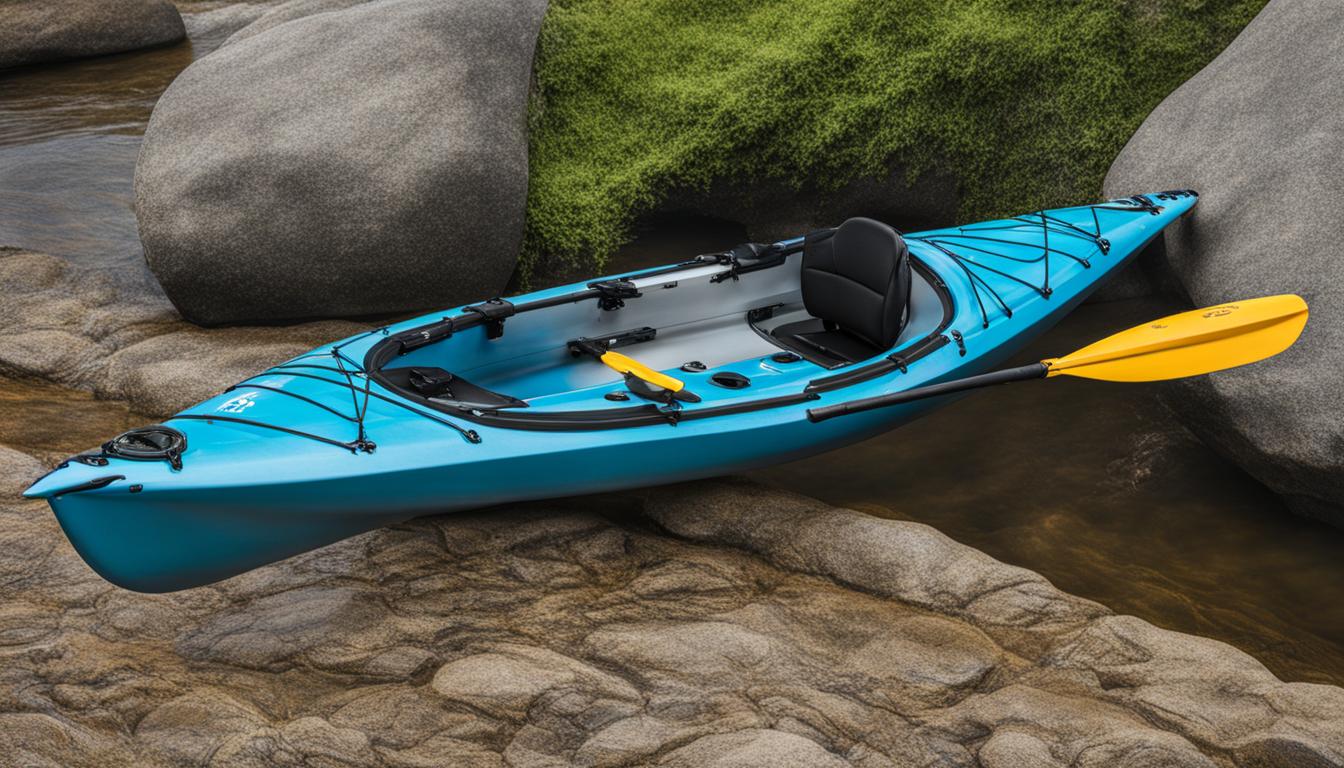Proper weight distribution is key when it comes to loading kayaks. Achieving optimal weight distribution not only enhances your paddling efficiency but also ensures your safety on the water. By distributing the weight evenly across your kayak, you can enjoy improved stability, enhanced maneuverability, and better overall trim. Additionally, considering your kayak’s weight limit and keeping essential gear easily accessible are important factors to keep in mind when loading your kayak.
Key Takeaways:
- Proper weight distribution is crucial for optimal paddling efficiency and safety.
- Distribute weight evenly across your kayak to enhance stability, maneuverability, and trim.
- Know your kayak’s weight limit and keep essential gear easily accessible.
- Place heavier items in the center of the kayak and lighter items on the deck.
- Consider safety concerns and special placements for emergency gear.
Importance of Weight Distribution in Kayaks
Proper weight distribution in kayaks is important for several reasons. It affects kayak stability by ensuring that the heaviest gear is packed low in the kayak and that the lighter items are placed on the deck. This reduces the chance of the kayak becoming top-heavy and improves overall stability. Additionally, weight distribution impacts paddling speed, as a lighter bow helps the kayak catch the wind when traveling downwind. It also affects the ability to maneuver the kayak, as even weight distribution makes it easier to turn and navigate. Finally, proper weight distribution helps maintain the trim of the kayak, ensuring it is balanced and stable.
When it comes to roof transport, balancing kayaks is crucial for safety. Uneven loading can cause the kayak to shift while driving, leading to instability and potential accidents. To ensure even loading for kayak safety, using kayak weight distribution systems can be beneficial. These systems, such as kayak load stabilizers, help distribute the weight evenly across the roof rack, minimizing the risk of the kayak shifting during transport. By implementing these systems, you can have peace of mind knowing that your kayak is securely and evenly loaded for a safe journey.
“Proper weight distribution in kayaks is not only important for safety but also for optimal performance. It can significantly improve stability, maneuverability, and overall paddling experience.”
Whether you are a novice or experienced kayaker, understanding and implementing proper weight distribution techniques is essential. By following best practices and applying the tips mentioned in this article, you can ensure that your kayak is loaded correctly for enhanced stability, maneuverability, and overall safety. Remember, proper weight distribution is the key to a smooth and enjoyable kayaking adventure.
| Importance of Proper Weight Distribution in Kayaks | Benefits |
|---|---|
| Enhanced stability | Improved maneuverability |
| Optimal paddling efficiency | Reduced risk of accidents |
| Improved trim of the kayak | Minimized chance of top-heaviness |
| Increased overall safety | Enhanced paddling experience |

Tips for Proper Weight Distribution in Kayaks
Proper weight distribution is key to achieving optimal performance and stability when kayaking. Follow these techniques for balanced kayak transport to ensure a smooth and safe paddling experience.
Distribution Guidelines:
When loading your kayak, it’s important to keep in mind a few key principles:
- Know Your Kayak’s Weight Limit: Stick to a maximum weight of 65% to 70% of your kayak’s capacity for best performance.
- Keep Essential Gear Close: Store small essential items like first aid kits, water bottles, and compasses within easy reach in day hatches or below/behind the seat.
- Keep the Ends Light: Place lightweight but bulky items like sleeping bags and clothing close to the ends of the kayak.
- Pack Heaviest Items to the Center: Pack heavier gear around the cockpit, low and centered in the kayak to maintain balance and stability.
- Pack Frequently Used Gear Near Hatch Cover: Keep frequently used items easily accessible, but separate from other gear packed in compartments.
Kayak Load Stabilizers:
In addition to following these weight distribution guidelines, you can also use kayak load stabilizers to enhance stability and minimize the risk of capsizing. These stabilizers attach to the sides of your kayak and provide extra support, especially when carrying heavy loads. They can help distribute the weight evenly and make your kayak more resistant to tipping.
Weight Distribution Advice:
When loading your kayak, always take into consideration the weight distribution of the items you’re carrying. Avoid placing all the heavy items on one side, as this can cause the kayak to lean to that side, affecting stability and maneuverability.

By following these tips and using kayak load stabilizers when necessary, you can ensure proper weight distribution in your kayak, enhancing your paddling experience and keeping you safe on the water.
Safety Concerns and Special Placements
When it comes to loading kayaks, maintaining safety is of utmost importance. Proper weight distribution is essential to ensure stability during transport. In addition to distributing the weight evenly, there are a few safety concerns and special placements to consider.
One crucial aspect is to ensure that certain items are easily accessible in case of emergencies. Items like first-aid kits, emergency paddles, signaling devices, and navigation equipment should be stored in specific areas and within reach. Under the seat, seat packs, or securely attached to the kayak are suitable locations for these essentials. By keeping them readily available, you can address any unforeseen situations promptly.
Aside from safety considerations, it’s also important to pack incidentals for convenience. Items like water, snacks, sunglasses, and cameras should be placed in easily reachable locations. This way, you can access them without disrupting the balance of the kayak. Remember, convenience can also contribute to a more enjoyable kayaking experience.
By prioritizing safety concerns and following the tips mentioned in the previous section, you can ensure that your kayak remains stable during transport. Keep essential items easily accessible and securely placed, and pack incidentals in accessible locations. These small steps can go a long way in ensuring a safe and enjoyable adventure on the water.
| Item | Recommended Placement |
|---|---|
| First-aid kits | Under the seat or in a seat pack |
| Emergency paddles | Securely attached to the kayak |
| Signaling devices | Under the seat or in a seat pack |
| Navigation equipment | Securely attached to the kayak |
| Water | In a reachable location |
| Snacks | In a reachable location |
| Sunglasses | In a reachable location |
| Camera | In a reachable location |
Conclusion
Proper kayak loading weight distribution is essential for optimal paddling performance and safety. By following the tips mentioned above, you can ensure that the weight is distributed evenly, maintaining stability, maneuverability, and trim.
Remember to be mindful of your kayak’s weight limit, keeping it within 65% to 70% of its capacity to achieve the best performance.
Keep small essential items like first aid kits, water bottles, and compasses within easy reach, storing them in day hatches or below/behind the seat. Place lightweight but bulky items like sleeping bags and clothing close to the ends of the kayak, while packing heavier gear around the cockpit, low and centered, to maintain balance and stability. Finally, keep frequently used gear easily accessible, but separate from other items packed in compartments.
By prioritizing weight distribution, you can enhance your kayaking experience and make your journey safer and more enjoyable. So remember to follow these tips, and have a fantastic time exploring the waterways with a properly loaded kayak!
FAQ
Why is proper weight distribution important when loading kayaks?
Proper weight distribution ensures kayak stability, enhances maneuverability, and improves the trim of the kayak.
How much weight should I keep in my kayak?
Stick to a maximum weight of 65% to 70% of your kayak’s capacity for best performance.
Where should I store essential gear in my kayak?
Store small essential items like first aid kits, water bottles, and compasses within easy reach in day hatches or below/behind the seat.
Where should I place lightweight items in my kayak?
Place lightweight but bulky items like sleeping bags and clothing close to the ends of the kayak.
Where should I pack heavier items in my kayak?
Pack heavier gear around the cockpit, low and centered in the kayak to maintain balance and stability.
How should I pack frequently used gear in my kayak?
Keep frequently used items easily accessible, but separate from other gear packed in compartments.
What safety concerns should I consider when loading my kayak?
Certain items like first-aid kits, emergency paddles, signaling devices, and navigation equipment should be conveniently located and easily accessible. Additionally, consider packing incidentals like water, snacks, sunglasses, and cameras in easily reachable locations for convenience.
How can I ensure my kayak is safe during transport?
Balancing kayaks for roof transport or using kayak weight distribution systems can help ensure stability during transport.
Why is even loading important for kayak safety?
Even loading helps maintain stability, reduces the chance of the kayak becoming top-heavy, and improves overall safety during paddling.





